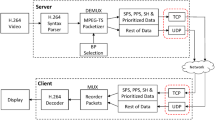Abstract
Nowadays, Media streaming services over TCP have become very popular because of the TCP’s reliability, which provides remarkable stability to the Internet. However, in order to offer a high media quality and a good user satisfaction, the media streaming service requires that transport protocols can be adapted continuously with the network parameters. However, the diversity, of terminals (i.e., tablet, smart phones, laptop … etc.) and their corresponding capabilities, means that users’ agnostic solutions are inefficient to cope with such diverse contexts. Indeed, the intrinsic characteristics and parameters of the terminal users (i.e., devices) need to be taken into account on the video streaming adaptation process. The classic adaptive video streaming services do not consider the user parameters on the adaptation process. In this paper, we propose an adaptive video streaming solution to improve the user satisfaction factor by adapting the TCP parameters according to the user’s parameters on mobile networks. The user satisfaction factor is calculated according to some metrics driven from the user’s quality of experience (QoE). The work is validated through our proposal based on a new mobile agent (which does all the work) developed on a Linux script platform and tested on different kinds of devices with different scenarios.











Similar content being viewed by others
References
Cisco White Paper: Cisco Visual Networking Index: Global Mobile Data Traffic Forecast Update, 2009–2014, http://bit.ly/bwGY7L
Claeys M, Latré S, Famaey J, Wu T, Leekwijck W, Turck F (2013) Design Of A Q-learning-based client quality selection algorithm for Http adaptive video streaming. In Proc Of Adaptive And Learning Agents Workshop, USA
Deep Singh K, Hadjadj-Aoul Y, Rubino G (2012) Quality of experience estimation for adaptive Http/Tcp video streaming using H.264/Avc, Ccnc”- Ieee Consumer Communications & Networking Conference Hal-00713723, Version 1
Douga Y, Bourenane M, Mellouk A (2014) Adaptive video streaming using tcp factors control with user parameters, proceeding of elsevier fnc’14, the 9th international conference on Future Networks and Communication, volume 34, 2014, pages 526–531, Niagara Falls, Canada
Fiadino P et al (2014) On the detection of network traffic anomalies in content delivery network services. In ITC 26
Haddad M, Altman E, El-Azouzi R, Jiménez T, Elayoubi S, Jamaa S, Legout A, Rao A (2011) A survey on youtube streaming service. In Proc Of The 5th International Icst Conference On Performance Evaluation Methodologies And Tools, Belgium
Hossfeld T, Seufert M, Hirth M, Zinner T, Tran-Gia P, Schatz R (2011) Quantification of YouTube QoE via crowdsourcing. In IEEE International Symposium on Multimedia (ISM), pages 494–499
IstvánKetykó, De Moor K, De Pessemier T, Verdejo AJ, Vanhecke K, Joseph W, Martens L, De Marez L (2010) QoE measurement of mobile youtube video streaming. MoViD ’10 Proceedings of the 3rd workshop on Mobile video delivery, Pages 27–32, ISBN: 978-1-4503-0165-7, ACM New York, NY, USA
Kim HJ, Yun DG, Kim H-S, Cho KS, Choi SG (2012) Qoe assessment model for video streaming service using qos parameters in wired-wireless network. In Advanced Communication Technology (ICACT), 2012 14th International Conference on, pages 459–464
Linck S, Mory E, Bourgeois J, Dedu E, Spies F (2014) Adaptive multimedia streaming using a simulation test bed. J Comput Sci. doi:10.1016/j.jocs.2014.02.004
Mellouk A, Cuadra Sanchez A (2014) Quality of experience engineering for customer added value services: from evaluation to monitoring, Wiley Ed./ISTE Publishing Knowledge, 12 Chapters (272 pages), ISBN: 9781848216723
Mellouk A, Hoceini S, Tran HA (2013) Quality of experience for multimedia, Wiley Ed./ISTE Publishing Knowledge, ISBN: 9781848215634
Metri G, Shi W, Brockmeyer M, Agrawal A (2014) Battery extender: an adaptive user-guided tool for power management of mobile devices, Ubicomp’14, Spetember 13–17, Seattle, WA, USA
Mushtaq S, Augustin B, Mellouk A (2014) QoE: user profile analysis for multimedia services. In Proc. Of the IEEE International Conference on Communications (ICC), Sydney, Australia, pp. 1–6
Stewart L, Hayes DA, Armitage G, Welzl M, Petlund A (2011) Multimedia-unfriendly tcp congestion control and home gateway queue management. Mmsys '11 Proceedings Of The Second Annual Acm Conference On Multimedia Systems, Pages 169–174, Isbn: 978-1-4503-0518-1, Acm New York, Ny, Usa
Sutton RS, Barto AG (1998) Reinforcement learning: an introduction (Adaptive Computation and Machine Learning). The MIT Press
Truong T-H, Nguyen T-H, Nguyen H-T (2012) On relationship between quality of experience and quality of service metrics for IMS-Based IPTV networks. In IEEE International Conference on Computing and Communication Technologies, Research, Innovation, and Vision for the Future (RIVF), pages 1–6
Author information
Authors and Affiliations
Corresponding author
Rights and permissions
About this article
Cite this article
Douga, Y., Bourenane, M., Mellouk, A. et al. TCP based-user control for adaptive video streaming. Multimed Tools Appl 75, 11347–11366 (2016). https://doi.org/10.1007/s11042-015-2857-1
Received:
Revised:
Accepted:
Published:
Issue Date:
DOI: https://doi.org/10.1007/s11042-015-2857-1




